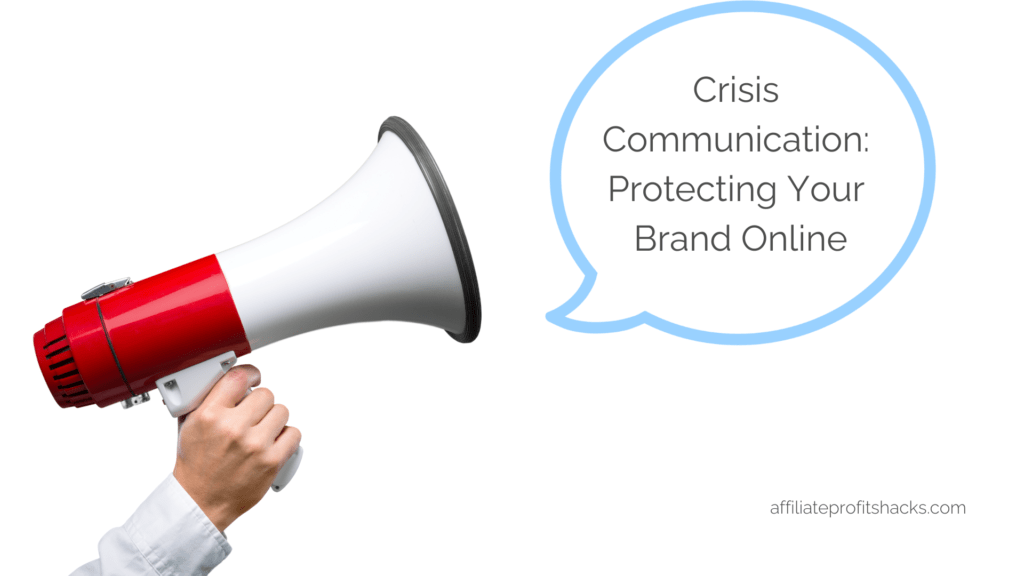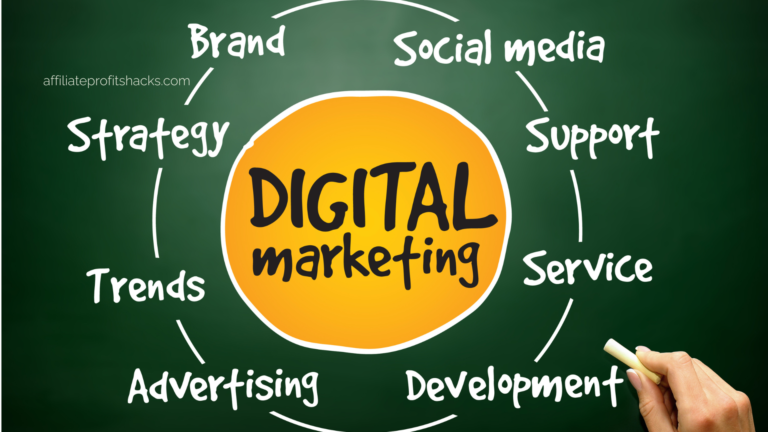Crisis Communication: Protecting Your Brand Online
Welcome to my article about crisis communication and how to protect your brand online!
Have you ever wondered how to safeguard your brand’s reputation amid a crisis? In today’s digital age, where information spreads like lightning, one wrong move can damage your brand’s online presence irreparably. But fear not! This article will explore the world of crisis communication and provide valuable insights on protecting your brand online.
Wake up to Reality: Good Jobs are Scarce, and Debt is Rampant. Discover How to Secure YOUR Financial Future Against the Odds!

Key Takeaways:
- It is important to understand the importance of crisis communication for brand reputation management.
- The impact of a crisis on your brand’s online reputation and how to mitigate it.
- Identifying potential online reputation crises and taking proactive measures.
- Developing an effective crisis communication strategy for a timely response.
- Social media is a powerful tool for managing crises and rebuilding your brand’s reputation.
The Importance of Online Reputation Management
Managing your online reputation is paramount in today’s digital age. It has a significant impact on your personal and professional life. It reflects your character, competence, and credibility, influencing the opportunities and successes that come your way. To ensure a positive online reputation, it is essential to implement effective crisis PR strategies, invest in digital brand protection, and perform online reputation repair when necessary.
One crucial aspect of online reputation management is monitoring social media platforms and online channels. Regularly tracking mentions of your brand allows you to address any negative feedback or reviews proactively. By promptly responding to customer concerns or complaints, you can mitigate potential damage to your online reputation and maintain a positive image.
In addition to monitoring social media, implementing search engine optimization (SEO) techniques is vital for managing your online reputation. Optimizing your website and online content helps ensure that positive information about your brand ranks higher in search engine results, making it more visible to potential customers.
Online reputation is not just about what others see. It’s about shaping your overall digital image and maintaining control over your brand perception.
Thus, effective crisis communication is essential for protecting and repairing your brand’s online reputation. A well-thought-out crisis PR strategy enables you to handle potential reputation crises efficiently and confidently. By promptly addressing and resolving issues, you can minimize the negative impact on your brand and rebuild trust among your target audience.
Understanding the Impact of a Crisis on Online Reputation
A crisis can significantly impact your company’s online reputation. When a crisis occurs, negative reviews, comments, and social media backlash can quickly tarnish your brand’s image. The loss of credibility and trust can be damaging and lead to long-term reputation damage if not managed effectively.
To effectively navigate a reputation crisis, it’s crucial to have a strong brand crisis communication plan and crisis management plan in place. By responding promptly and transparently, you can regain control of the narrative and rebuild trust with your audience. Case studies, such as Johnson & Johnson’s handling of the Tylenol crisis, can provide valuable insights into managing the impact of a crisis on online reputation.
Identifying Potential Online Reputation Crises
Managing your brand’s image online is crucial for maintaining a positive reputation in today’s digital landscape. By actively monitoring social media and various online platforms, you can identify potential reputation crises before they escalate. This proactive approach lets you promptly address issues and minimize potential damage to your brand’s online reputation.
One effective way to monitor your brand’s online presence is to utilize tools like Google Alerts and social media monitoring platforms. These tools can help you track mentions of your brand, negative reviews, and complaints in real-time. By staying informed about what is being said about your business, you can quickly identify any potential reputation crises and take appropriate action.
Regarding online reputation management, timely and public response is key. By responding promptly to any issues or concerns raised by customers or the public, you demonstrate your commitment to addressing their concerns and finding a resolution. This transparency and accountability can go a long way in maintaining your brand’s credibility and trustworthiness.
Monitoring social media and online platforms is like having your finger on the pulse of your brand’s reputation. It allows you to identify and address potential crises before they spiral out of control.
By proactively identifying potential reputation crises and responding to them effectively, you can take control of your brand’s online reputation. This helps protect your brand’s image and ensures that you consistently deliver a positive experience to your customers.
Developing a Crisis Communication Strategy
In times of crisis, having a well-defined crisis communication strategy is essential for effectively managing a reputation crisis and protecting your brand’s online reputation. By following a set of best practices, you can navigate the challenges and successfully come out on the other side. Here are key steps to develop a comprehensive crisis communication strategy:
- Identify your crisis communication team: Assemble a team responsible for managing and implementing your crisis communication plan. This team should include representatives from various departments with the necessary skills and knowledge to handle crises.
- Create a clear message: Define your key messages and ensure they are transparent, accurate, and consistent across all communication channels. Your message should address the crisis, reassure stakeholders, and provide relevant information.
- Choose suitable strategies: Determine the most effective communication strategies for your crisis. Whether through press releases, social media updates, email newsletters, or other channels, select the methods to reach your target audience and convey your message.
- Spread the message through relevant channels: To reach your audience, use a combination of online and offline channels. Leverage PR efforts, social media platforms, official websites, and other appropriate channels to disseminate your message effectively.
- Analyze the results: Continuously monitor and evaluate the effectiveness of your crisis communication efforts. Use analytics tools, stakeholder feedback, and other metrics to assess the impact of your strategy and make necessary adjustments.
Wake up to Reality: Good Jobs are Scarce, and Debt is Rampant. Discover How to Secure YOUR Financial Future Against the Odds!
Learning from successful case examples and implementing crisis communication best practices are crucial in developing an effective crisis communication strategy. By incorporating these steps into your plan and utilizing social listening tools to stay informed, you can navigate crises while minimizing reputational damage and preserving trust with your audience.
Responding Effectively to a Crisis
When a crisis occurs, effectively responding is vital. In today’s digital age, social media crisis communication plays a crucial role in managing and controlling the narrative surrounding a brand’s reputation. Social media listening tools, such as Brandwatch or Sprout Social, can help track negative trends and sentiments, allowing you to respond immediately and appropriately.
One essential aspect of crisis communication is involving a spokesperson in official responses. Customers want to see a brand take responsibility and address the crisis directly. Having a designated spokesperson demonstrates your commitment to resolving the issue and building confidence with your audience.
In addition to promptly responding and involving a spokesperson, creative approaches can also be employed to benefit from negative information and turn it into an advantage. For example, brands can use humor or empathy to diffuse tension and rebuild trust with their audience.
In times of crisis, effective communication is key. It’s crucial to listen, understand, and respond promptly to the concerns of your customers. By doing so, you address their issues and show that you value their opinions and are committed to finding a solution.
In summary, responding effectively to a crisis requires employing social media listening tools, involving a spokesperson in official responses, and employing creative approaches. By doing so, you can effectively manage the crisis, address customer concerns, and rebuild trust in your brand.
Preparing for a Crisis: Creating an Emergency Communications Plan
Crises can occur anytime in today’s unpredictable world, potentially impacting your brand’s reputation. That’s why it’s crucial to have a well-prepared emergency communications plan in place. By anticipating potential crises and establishing a clear strategy, you can effectively manage and mitigate the impact on your brand’s online reputation. Let’s explore the key steps involved in creating an emergency communications plan.
Identifying a Crisis Communication Team
First and foremost, assemble a crisis response team consisting of individuals from different departments within your organization. This team should include representatives of public relations, marketing, legal, and executive leadership. Each member should understand their role and responsibilities in crisis management, ensuring a coordinated and effective response.
Creating Clear Messages

Clear and consistent messaging is crucial during a crisis to maintain transparency and trust with your stakeholders. Work as a team to develop concise, honest messages that convey empathy, address concerns, and provide accurate information. These messages should align with your brand values and reassure your audience that you are actively managing the situation.
Spreading Messages through Relevant Channels
Once your crisis communication messages are finalized, choosing the most appropriate channels to disseminate them is important. These may include your website, social media platforms, email newsletters, and press releases. Tailor your messaging to suit each channel while ensuring consistency across all platforms. By utilizing relevant channels, you can reach your target audience effectively.
Real-time Analysis and Social Media Monitoring
Monitoring social media platforms and other online channels throughout the crisis is crucial. By tracking mentions of your brand, you can gauge public sentiment, identify potential issues, and promptly respond to any emerging threats. The real-time analysis allows you to adapt your crisis communication strategy and address concerns before they escalate.
A well-prepared crisis management plan and an effective crisis response team is key to successfully navigating a crisis. By creating clear messages, spreading them through relevant channels, and continuously analyzing the situation, you can minimize the impact on your brand’s online reputation, regain customer trust, and emerge stronger.
The Anatomy of a Social Media Crisis
Understanding the triggers and characteristics of a social media crisis is crucial for effective crisis management. Negative customer feedback, viral controversies, hacking incidents, and public relations disasters can all contribute to a social media crisis. Being aware of these factors and knowing how to spot them early allows for proactive crisis response and damage control.
Social media crises can arise from various sources and have the potential to significantly impact a brand’s reputation. It’s important to identify the triggers and understand the anatomy of such crises to effectively mitigate their consequences.
Negative customer feedback is one of the triggers for a social media crisis. When customers express dissatisfaction with a product or service on platforms like Twitter or Facebook, their comments can quickly go viral and result in a public relations nightmare. Monitoring customer sentiment and promptly addressing issues can help prevent negative feedback from escalating into a full-blown crisis.
Spotting viral controversies
Viral controversies are another common source of social media crises. Posts, videos, or campaigns that generate widespread public outrage and backlash can tarnish a brand’s reputation overnight. Keeping a watchful eye on trending topics, hashtags, and industry-related conversations can help identify potential controversies before they spiral out of control.
Furthermore, hacking incidents significantly threaten a brand’s social media presence. Unauthorized access to social media accounts can lead to the dissemination of false information, offensive posts, or even fraudulent activities. Implementing robust security measures and promptly responding to any signs of a breach is crucial to minimizing the damage caused by a social media crisis.
Wake up to Reality: Good Jobs are Scarce, and Debt is Rampant. Discover How to Secure YOUR Financial Future Against the Odds!
The impact of public relations disasters
Public relations disasters, such as a controversial statement by a celebrity spokesperson or an ill-conceived ad campaign, can trigger a social media crisis that spreads like wildfire. These incidents often lead to widespread negative publicity, public backlash, and calls for boycotts. Recognizing potential PR pitfalls and carefully managing brand messaging can help prevent such disasters from escalating into full-blown crises.
In conclusion, understanding the triggers and characteristics of a social media crisis is essential for effective crisis management. By being proactive and vigilant, brands can identify potential crisis triggers, respond promptly to negative customer feedback, and mitigate the impact of viral controversies, hacking incidents, and public relations disasters. Remember, a well-prepared crisis communication strategy can make all the difference in protecting your brand’s reputation online.
Leveraging Social Media in Crisis Management
Social media platforms play a significant role in crisis management. In today’s digital landscape, where information spreads rapidly, monitoring social media conversations is crucial to avoid potential crises. You can promptly identify negative mentions and address issues by actively monitoring platforms like Twitter, Facebook, and Instagram.
When responding to negative mentions on social media, it’s important to be transparent and empathetic and provide accurate information. Prompt responses can help prevent issues from escalating and demonstrate your commitment to resolving the situation. Leverage the power of social media to reach your audience directly and address their concerns.
Social media is not just an activity; it is an investment of valuable time and resources. Surround yourself with people who not just support you and stay with you, but inform your thinking about ways to ‘WOW’ your online presence.
During a crisis, social media platforms can be powerful tools for managing the narrative and controlling the flow of information. Sharing regular updates with your audience lets you inform them about your progress and steps to address the crisis. Engaging with customers on social media demonstrates your commitment to transparency and helps you regain their trust.
Strategically leveraging social media in crisis communication allows you to regain control, shape public perception, and rebuild your brand’s reputation. By actively monitoring, responding promptly, and sharing updates on social media platforms, you can effectively manage and mitigate the impact of a crisis on your brand.
Rebuilding and Repairing Online Reputation After a Crisis
After experiencing a crisis, the work doesn’t end there. Rebuilding and repairing your brand’s online reputation is crucial to regain trust and credibility. Taking proactive steps to analyze what went wrong, making necessary improvements, and demonstrating a commitment to rectifying the situation are important initial steps.
Consistency is key to rebuilding your brand’s reputation. By publishing positive content, engaging with customers, and closely monitoring online sentiment, you can actively contribute to regaining your audience’s trust. Remember, reputation recovery takes time and effort but is achievable with the right strategies.
Rebuilding a damaged reputation is not about changing the past, but rather about shaping the future.
Tips for Rebuilding and Repairing Your Brand Image
- Be transparent and acknowledge the crisis: Address the issue head-on, take responsibility, and apologize if necessary. Transparency helps rebuild trust with your audience.
- Implement improvements: Analyze what caused the crisis and make necessary changes to prevent it from happening again. Continuous improvement shows your commitment to rectifying the situation.
- Create positive content: Actively publish positive content about your brand to counterbalance negative perceptions. This can include success stories, testimonials, or updates about improvements made.
- Engage with your customers: Respond promptly and respectfully to customer inquiries, reviews, and feedback. Show genuine concern and willingness to address any concerns or issues.
- Monitor and manage online sentiment: Stay vigilant and actively monitor online platforms for mentions of your brand. Address and manage negative sentiment promptly to prevent further damage to your brand’s reputation.
By following these strategies and consistently working towards rebuilding your brand’s reputation, you can successfully recover from a crisis and rebuild a positive brand image. Remember, reputation recovery is a continuous process that requires dedication and ongoing efforts.
Proactive Steps for Long-Term Online Reputation Management
While managing a crisis is important, taking proactive steps to prevent future crises is even better. By implementing proactive reputation management practices, you can protect your brand’s online reputation in the long term.
Employee Training
Providing comprehensive employee training is one of the best ways to safeguard your brand’s online reputation. Educate them on the importance of maintaining a positive online image and the potential risks associated with their actions on social media. Fostering a company culture that values professionalism and responsible online behavior can minimize the chances of reputation-damaging incidents.
Clear Social Media Guidelines
Establishing clear guidelines for social media usage within your organization is crucial. Clearly outline what is acceptable and what is not in terms of content, tone, and engagement. Encourage employees to use social media responsibly and provide guidance on handling negative feedback or controversial topics. By setting these guidelines, you can mitigate the risks of damaging your brand’s online reputation.
Regular Risk Assessments
Regular risk assessments are essential for identifying potential reputation risks and addressing them proactively. Monitor social media platforms, review customer feedback, and stay updated on industry trends and news that may impact your brand’s reputation. You can anticipate potential crises and intervene before they escalate by staying vigilant and proactive.
By implementing proactive reputation management practices, you can protect your brand’s online reputation in the long term.
Prioritizing proactive reputation management can establish a strong foundation for your brand’s online presence. Remember to stay informed, prepared, and actively manage your online reputation. These steps will help you maintain a positive image and protect your brand’s reputation despite challenges.
Conclusion
Crisis communication is critical in today’s digital landscape for managing brand reputation effectively. Understanding the importance of online reputation and its impact on a brand’s credibility is the first step toward successful crisis communication. By promptly identifying potential crises and developing a comprehensive crisis communication strategy, businesses can minimize the damage caused by negative events and protect their reputation.
Wake up to Reality: Good Jobs are Scarce, and Debt is Rampant. Discover How to Secure YOUR Financial Future Against the Odds!
Responding to a crisis efficiently and strategically is vital. Utilizing social media platforms like Twitter and Facebook allows brands to address the situation directly and transparently, demonstrating their commitment to resolving the issue and rebuilding trust with their audience. By engaging with customers during a crisis, brands can control the narrative and regain their online reputation.
However, crisis communication is not just about reactive efforts; it also involves proactive steps to prevent future crises. By implementing employee training programs, establishing clear social media guidelines, and conducting regular risk assessments, brands can minimize the likelihood of a crisis occurring in the first place. Businesses can ensure long-term brand reputation and credibility by staying vigilant and actively managing their online reputation.
Thank you for reading my article “Crisis Communication: Protecting Your Brand Online.” I hope you found it informative and helpful!
For more insights into effective communication, read this article: Effective Communication Practices for Remote Teams.







